Click on the following marker names for additional information.
March to the Sea: Ebenezer Creek – Rincon
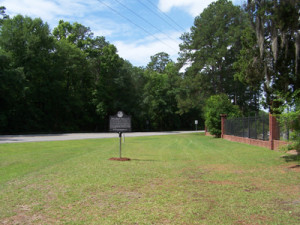 March to the Sea: Ebenezer Creek
March to the Sea: Ebenezer Creek
Marker Time Period: 19th Century, Civil War
County: Effingham
Marker Program: Georgia Historical Society
Region: Lowcountry
Marker Text: One mile north, on December 9, 1864, during the American Civil War, U.S. Gen. Jeff. C. Davis crossed Ebenezer Creek with his 14th Army Corps as it advanced toward Savannah during Gen. William T. Sherman’s March to the Sea. Davis hastily removed the pontoon bridges over the creek, and hundreds of freed slaves following his army drowned trying to swim the swollen waters to escape the pursuing Confederates. Following a public outcry, Sec. of War Edwin Stanton met with Sherman and local black leaders in Savannah on January 12, 1865. Four days later, President Lincoln approved Sherman’s Special Field Orders No. 15, confiscating over 400,000 acres of coastal property and redistributing it to former slaves in 40-acre tracts.
Erected for the Civil War 150 commemoration by the Georgia Historical Society and the Georgia Department of Economic Development
Tips for Finding This Marker: GA Hwy 275 In front of the Historic Ebenezer Cemetery at the New Ebenezer Family Retreat.
Explosion at the Confederate Powder Works – Augusta
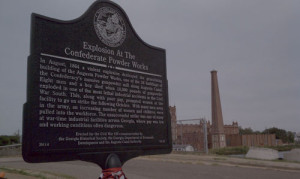 Explosion At The Confederate Powder Works
Explosion At The Confederate Powder Works
Marker Time Period: 19th Century, Civil War
Region: Coastal Plain
Marker Program: Georgia Historical Society
County: Richmond
Marker Text: In August, 1864 a violent explosion destroyed the granulating building of the Augusta Powder Works, one of the 28 buildings of the Confederacy’s massive gunpowder mill along Augusta Canal. Eight men and a boy died when 18,000 pounds of gunpowder exploded in one of the most lethal industrial accidents in the Civil War South. This, along with poor pay, prompted women at the facility to go on strike the following October. With many men away in the army, an increasing number of women and children were pulled into the workforce. The unsuccessful strike was one of many at war-time industrial facilities across Georgia, where pay was low and working conditions often dangerous.
Erected for the Civil War 150 commemoration by the Georgia Historical Society, the Georgia Department of Economic Development, and the Augusta Canal Authority.
Tips for Finding This Marker: On Eve Street, northeast of Broad Street in Augusta.
Civil War Women's Riot – Columbus
Civil War Women’s Riot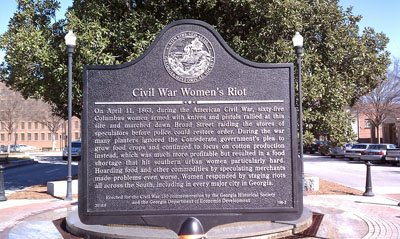
Marker Time Period: 19th Century, Civil War
Marker Subject: Georgia Governors, Military History, Politics, Women’s History
Marker Program: Georgia Historical Society
County: Muscogee
Region: Piedmont
Marker Text: On April 11, 1863, during the American Civil War, sixty-five Columbus women armed with knives and pistols rallied at this site and marched down Broad Street raiding the stores of speculators before police could restore order. During the war many planters ignored the Confederate government’s plea to grow food crops and continued to focus on cotton production instead, which was much more profitable but resulted in a food shortage that hit southern urban women particularly hard. Hoarding food and other commodities by speculating merchants made problems even worse. Women responded by staging riots all across the South, including in every major city in Georgia.
Erected for the Civil War 150 commemoration by the Georgia Historical Society and the Georgia Department of Economic Development in 2010.
Tips for Finding This Marker: On Broadway, between 13th and 14th Streets in Columbus
Georgia's Secession Convention – Milledgeville
 Georgia’s Secession Convention
Georgia’s Secession Convention
Marker Time Period: 19th Century, Civil War
County: Baldwin
Marker Program: Georgia Historical Society
Region: Piedmont
Marker Text: On January 16, 1861, the Georgia Secession Convention met here to consider seceding from the United States. Secession began in response to Abraham Lincoln’s election as president the previous November and the belief that his Republican party was “anti-slavery in its mission and its purpose,” according to Georgia’s secession ordinance. Secession was not a foregone conclusion; initially a slim majority of delegates were opposed to it. After three days of strident rhetoric on both sides of the question, the final vote on January 19 was decidedly pro-secession, 208-89. Delegate Alexander Stephens warned that secession meant war and “who but this Convention will be held responsible for it?” Secession was never put to a popular vote.
Erected for the Civil War 150 commemoration by the Georgia Historical Society, the Georgia Battlefields Association, and the Georgia Department of Economic Development.
Tips for Finding This Marker: At the intersection of East Greene and South Jefferson Streets in Milledgeville
African-American Soldiers in Combat – Dalton
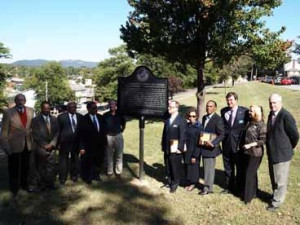 African-American Soldiers in Combat
African-American Soldiers in Combat
Marker Time Period: 19th Century, Civil War
Marker Program: Georgia Historical Society
Region: Mountain
County: Whitfield
Marker Text: Near Dalton on August 15, 1864, during the Civil War, the 14th United States Colored Troops (USCT), whose enlisted men were mostly former slaves, helped drive off a Confederate cavalry attack on the Western and Atlantic Railroad, U.S. General William T. Sherman’s main supply line during the Atlanta Campaign. Later, on October 13, 1864, the 44th USCT was in a fort protecting the railroad through Dalton when the garrison commander surrendered to Confederate General John B. Hood. In accordance with Confederate policy, many of the 600 captured black troops were returned to slavery. Black troops rarely saw combat in Georgia, though nearly 200,000 African Americans served in the U.S. armed forces during the war.
Erected for the Civil War 150 commemoration by the Georgia Historical Society, the Georgia Battlefields Association and the Georgia Department of Economic Development in 2010.
Tips for Finding This Marker: At 104 Fort Hill Terrace in Dalton
Civil War Slave Conspiracy – Quitman
 Civil War Slave Conspiracy
Civil War Slave Conspiracy
Marker Time Period: 19th Century, Civil War
County: Brooks
Region: Coastal Plain
Marker Program: Georgia Historical Society
Marker Text: In August 1864, during the American Civil War, four men were executed in Brooks County, Georgia, for conspiring to plot a slave insurrection. The conspirators – led by a local white man, John Vickery, and three slaves named elson, George, and Sam – planned to seize weapons and take control of the town of Quitman, securing it for the U.S. Army in nearby Florida. Local authorities discovered the plot before it could be carried out. All four conspirators were convicted of insurrection and executed on August 22, 1864. Anti-Confederate activity such as this, along with food riots, draft evasion, and labor unrest, increased during the final year of the war.
Erected for the Civil War 150 commemoration by the Georgia Historical Society and the Georgia Department of Economic Development.
Tips for Finding This Marker: At 100 West Screven Street in Quitman
Georgians in the Union Army – Dawsonville
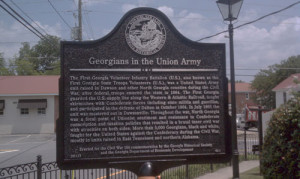 Georgians in the Union Army
Georgians in the Union Army
Marker Time Period: 19th Century, Civil War
County: Dawson
Marker Program: Georgia Historical Society
Region: Mountain
Marker Text: The First Georgia Volunteer Infantry Battalion (U.S.), also known as the First Georgia State Troops Volunteers (U.S.), was a United States Army unit raised in North Georgia during the Civil War, after federal troops entered the state in 1864. The First Georgia guarded the U.S. supply line along the Western & Atlantic Railroad, fought skirmishes with Confederate forces including state militia and guerrillas, and participated in the unsuccessful Federal defense of Dalton in October 1864. Throughout the war, North Georgia was a focal point of Unionist sentiment and resistance to Confederate conscription and taxation policies that resulted in a brutal inner civil war with atrocities on both sides. More than 5,000 Georgians, black and white, fought for the United States against the Confederacy during the Civil War, mostly in units raised in East Tennessee and northern Alabama.
Erected for the Civil War 150 commemoration by the Georgia Historical Society and the Georgia Department of Economic Development.
Tips for Finding This Marker: At the county courthouse in Dawsonville
The Battles for Atlanta – Atlanta
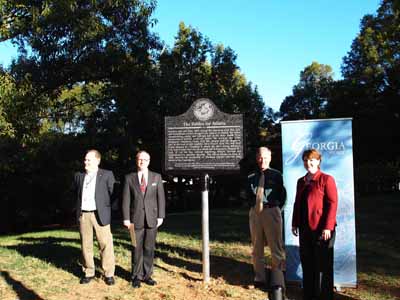 The Battles for Atlanta
The Battles for Atlanta
Marker Time Period: 19th Century, Civil War
Region: Atlanta Metro
Marker Place: Battlefield
County: Fulton
Marker Program: Georgia Historical Society
Marker Text: Between July and Sept. 1864, during the American Civil War, U.S. and Confederate armies struggled for control of Atlanta, the major manufacturing center and railroad hub of the Deep South. Four inconclusive battles occurred inside the present day I-285 Perimeter: Peachtree Creek (July 20), Atlanta (July 22, fought in part in the area of this marker), Ezra Church (July 28); and Utoy Creek (August 6). Unwilling to attack the city’s strong defenses, U.S. forces swept west and then south and at Jonesboro (August 31-Sept. 1) cut the last railroad supplying Atlanta, forcing the Confederates to abandon the city. The fall of Atlanta on Sept. 2, 1864, assured the re-election of Abraham Lincoln and the final defeat of the Confederacy.
Erected for the Civil War 150 commemoration by the Georgia Historical Society, the Georgia Battlefields Association and the Georgia Department of Economic Development.
Tips for Finding This Marker: At 453 Freedom Parkway in Atlanta
History of Emancipation: Sherman’s Special Field Orders No. 15 – Savannah
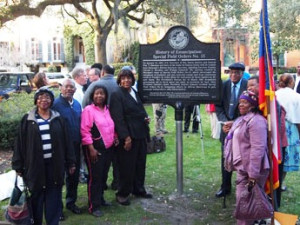 History of Emancipation: Special Field Orders No. 15
History of Emancipation: Special Field Orders No. 15
Marker Time Period: 19th Century, Civil War
County: Chatham
Marker Program: Georgia Historical Society
Region: Lowcountry
Marker Text: On January 12, 1865, U.S. Secretary of War Edwin Stanton and General Wm. T. Sherman met here at the home of Charles Green with 20 leaders from Savannah’s African-American churches, including Garrison Frazier, Ulysses L. Houston, and William Campbell. The meeting resulted in Sherman’s issue of Special Field Orders No.15, which encouraged the enlistment of freedmen and also reserved coastal land from Charleston south to Florida’s St. Johns River for settlement by freed families in 40-acre tracts. The Freedmen’s Bureau Act of March 1865 formalized government aid to freed slaves but made no provision for land. After President Lincoln’s death, President Andrew Johnson revoked Special Field Orders No.15, hampering efforts by African Americans to gain economic independence after Emancipation.
Erected for the Civil War 150 commemoration by the Georgia Historical Society, the Georgia Battlefields Association and the Georgia Department of Economic Development
Tips for Finding This Marker: Madison Square. Harris and Bull Streets, Savannah. Across the street from the Green-Meldrim house.
The Burning and Destruction of Atlanta – Atlanta
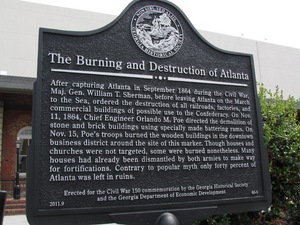 The Burning and Destruction of Atlanta
The Burning and Destruction of Atlanta
Marker Time Period: 19th Century, Civil War
Region: Atlanta Metro
County: Fulton
Marker Program: Georgia Historical Society
Erected for the Civil War 150 commemoration by the Georgia Historical Society and the Georgia Department of Economic Development.
Tips for Finding This Marker: At the intersection of Martin Luther King Jr. Drive and Central Avenue in Atlanta
General Cleburne’s Proposal to Arm Slaves – Dalton
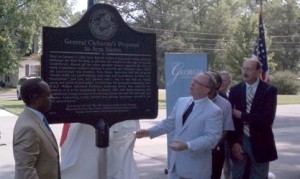 General Cleburne’s Proposal to Arm Slaves
General Cleburne’s Proposal to Arm Slaves
Marker Time Period: 19th Century, Civil War
Marker Program: Georgia Historical Society
Region: Mountain
County: Whitfield
Marker Text: Here on January 2, 1864, Gen. Patrick Cleburne proposed arming slaves in exchange for their freedom to alleviate the manpower shortage facing the Confederacy. Almost all the other generals present opposed the idea of black Confederate soldiers because it violated the principles upon which the Confederacy was founded. Gen. Patton Anderson said the proposal “would shake our governments, both state and Confederate, to their very foundations,” and Gen. A.P. Stewart said it was “at war with my social, moral and political principles.” Considering the proposal treasonous, Gen. W.H.T. Walker informed President Jefferson Davis, who ordered any mention of it to be suppressed. In March 1865, with defeat looming, the Confederate Congress approved enlisting slaves, but few did and none saw combat. Conversely, nearly 200,000 free African Americans served in the U.S. armed forces.
Erected for the Civil War 150 commemoration by the Georgia Historical Society, the Georgia Battlefields Association, and the Georgia Department of Economic Development in 2011.
Tips for Finding This Marker: At 314 North Selvidge Street in Dalton
The Madden Branch Massacre: Anti-Confederate Activity in North Georgia – McCaysville
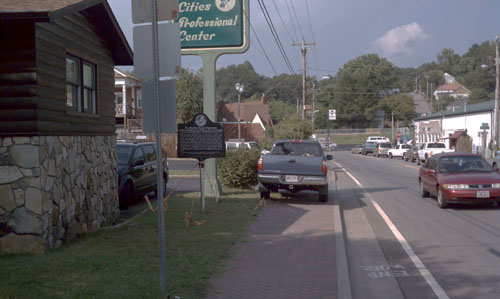 The Madden Branch Massacre: Anti-Confederate activity in North Georgia
The Madden Branch Massacre: Anti-Confederate activity in North Georgia
Marker Time Period: 19th Century, Civil War
County: Fannin
Marker Program: Georgia Historical Society
Region: Mountain
Marker Text: North of here on Madden Branch in Polk County, Tennessee, on November 29, 1864, during the American Civil War, six Georgians trying to enlist in the U.S. Army – Thomas Bell, Harvey Brewster, James T. Hughes, James B. Nelson, Elijah Robinson, Peter Parris, and Wyatt J. Parton – were executed by the notorious Confederate guerrilla John P. Gatewood, “the long-haired, red-bearded beast from Georgia.” The Madden Branch Massacre was one of several atrocities that occurred as the mountain counties divided into pro and anti-Confederate factions. Many Georgians resented the Confederacy’s strong central government measures such as conscription, impressment, and taxation and resisted by enlisting in the 5th Tennessee Mounted Infantry (U.S.) and the 1st Georgia State Troops Volunteers (U.S.) or forming their own guerilla units.
Erected for the Civil War 150 commemoration by the Georgia Historical Society and the Georgia Department of Economic Development in 2011.
Tips for Finding This Marker: On Blue Ridge Drive in McCaysville
William Clayton Fain: Georgia Unionist – Blue Ridge
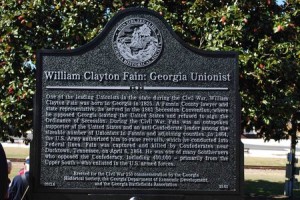 William Clayton Fain: Georgia Unionist
William Clayton Fain: Georgia Unionist
Marker Time Period: 19th Century, Civil War
County: Fannin
Marker Program: Georgia Historical Society
Region: Mountain
Marker Text: One of the leading Unionists in the state during the Civil War, William Clayton Fain was born in Georgia in 1825. A Fannin County lawyer and state representative, he served in the 1861 Secession Convention, where he opposed Georgia leaving the United States and refused to sign the Ordinance of Secession. During the Civil War, Fain was an outspoken supporter of the United States and an anti-Confederate leader among the sizeable number of Unionists in Fannin and adjoining counties. In 1864, the U.S. Army authorized him to raise recruits, which he conducted into Federal lines. Fain was captured and killed by Confederates near Ducktown, Tennessee, on April 6, 1864. He was one of many Southerners who opposed the Confederacy, including 400,000 – primarily from the Upper South – who enlisted in the U.S. armed forces.
Erected for the Civil War 150 commemoration by the Georgia Historical Society, the Georgia Department of Economic Development, and the Georgia Battlefields Association
Birthplace of Gen. Montgomery C. Meigs – Augusta
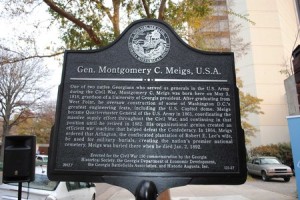 Gen. Montgomery C. Meigs, U.S.A.
Gen. Montgomery C. Meigs, U.S.A.
Marker Time Period: 19th Century, Civil War
Marker Program: Georgia Historical Society
Region: Piedmont
County: Richmond
Marker Text: One of two native Georgians who served as generals in the U.S. Army during the Civil War, Montgomery Meigs was born here on May 3, 1816, grandson of University of Georgia president. After graduating from West Point, he oversaw construction of some of Washington D.C.’s greatest architectural feats, including the U.S. Capitol Dome. Meigs became Quartermaster General of the U.S. Army in 1861, coordinating the massive supply effort throughout the Civil War, and continuing in that position until he retired in 1882. His organizational genius created an efficiant war machine that helped defeat the Confederacy. In 1864, Meigs ordered that Arlington, the confiscated plantation of Robert E. Lee’s wife, be used for military burials, creating the nation’s premier national cemetary. Meigs was buried there when he died Jan. 2, 1882.
Erected for the Civil War 150 commemoration by the Georgia Historical Society, the Georgia Department of Economic Development, the Georgia Battlefields Association, and Historic Augusta, Inc.
Birthplace of Gen. John C. Fremont – Savannah
 Birthplace of John C. Fremont
Birthplace of John C. Fremont
Marker Time Period: 19th Century, Civil War
County: Chatham
Region: Lowcountry
Marker Text: One of two native Georgians who served as generals in the U.S. Army during the Civil War, John C. Frémont was born nearby on January 21, 1813. As an army officer, his 1840s explorations of the American West gained him fame as the “Pathfinder.” During the U.S.-Mexican War, Frémont seized California for the U.S. and was elected one of its first Senators in 1850. Opposed to slavery’s expansion, he ran unsuccessfully in 1856 as the first Republican presidential candidate. During the Civil War, Frémont’s 1861 proclamation freeing all Confederate-owned slaves in Missouri was annulled by President Lincoln. After lackluster performance as a combat commander, Frémont resigned from the U.S. Army in 1864. He later served as governor of the Arizona Territory (1878-1881) and died in New York in 1890.
Erected for the Civil War 150 commemoration by the Georgia Historical Society, the Georgia Department of Economic Development, and the Georgia Battlefields Association
March to the Sea - Atlanta
March to the Sea – Atlanta
Region: Atlanta Metro
Marker Time Period: Civil War
County: Fulton
Marker Program: Georgia Historical Society
Marker Place: Library
Marker Subject: Military History
Marker Text: The March to the Sea
On November 15, 1864, during the Civil War, U.S. forces under Gen. William T. Sherman set out from Atlanta on the March to the Sea, a military campaign designed to destroy the Confederacy’s ability to wage war and break the will of its people to resist. After destroying Atlanta’s industrial and business (but not residential) districts, Sherman’s 62,500 men marched over 250 miles, reaching Savannah in mid-December. Contrary to popular myth, Sherman’s troops primarily destroyed only property used for waging war – railroads, train depots, factories, cotton gins, and warehouses. Abandoning their supply base, they lived off the land, destroying food they could not consume. They also liberated thousands of enslaved African Americans in their path. Sherman’s “hard hand of war” demoralized Confederates, hastening the end of slavery and the reunification of the nation.
Erected for the Civil War 150 commemoration by the Georgia Historical Society and the Georgia Battlefields Association
March to the Sea - Savannah
March to the Sea – Savannah
Marker Time Period: 19th Century, Civil War
County: Chatham
Marker Program: Georgia Historical Society
Region: Lowcountry
Marker Subject: Military History
Marker Place: Park
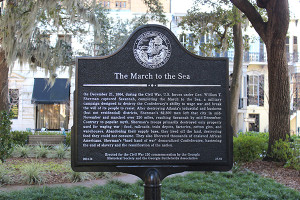 Marker Text: On December 21, 1864, during the Civil War, U.S. forces under Gen. William T. Sherman captured Savannah, completing the March to the Sea, a military campaign designed to destroy the Confederacy’s ability to wage war and break the will of its people to resist. After destroying Atlanta’s industrial and business (but not residential) districts, Sherman’s 62,500 men left that city in mid-November and marched over 250 miles, reaching Savannah by mid-December. Contrary to popular myth, Sherman’s troops primarily destroyed only property used for waging war – food, railroads, train depots, factories, cotton gins, and warehouses. Abandoning their supply base, they lived off the land, destroying food they could not consume. They also liberated thousands of enslaved African Americans. Sherman’s “hard hand of war” demoralized Confederates, hastening the end of slavery and the reunification of the nation.
Marker Text: On December 21, 1864, during the Civil War, U.S. forces under Gen. William T. Sherman captured Savannah, completing the March to the Sea, a military campaign designed to destroy the Confederacy’s ability to wage war and break the will of its people to resist. After destroying Atlanta’s industrial and business (but not residential) districts, Sherman’s 62,500 men left that city in mid-November and marched over 250 miles, reaching Savannah by mid-December. Contrary to popular myth, Sherman’s troops primarily destroyed only property used for waging war – food, railroads, train depots, factories, cotton gins, and warehouses. Abandoning their supply base, they lived off the land, destroying food they could not consume. They also liberated thousands of enslaved African Americans. Sherman’s “hard hand of war” demoralized Confederates, hastening the end of slavery and the reunification of the nation.
Erected for the Civil War 150 commemoration by the Georgia Historical Society and the Georgia Battlefields Association
CSS Georgia - Savannah
CSS Georgia: The “Ladies’ Gunboat”
Marker Time Period: 19th Century, Civil War
County: Chatham
Marker Program: Georgia Historical Society
Region: Lowcountry
Marker Subject: Military History, Women’s History
Marker Place: Military Installation
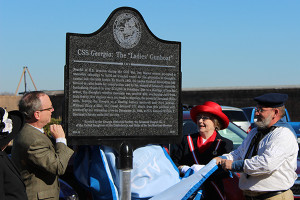 Marker Text: Fearful of U.S. invasion during the Civil War, two Macon women prompted a statewide campaign to build an ironclad vessel for the protection of Georgia’s coastal and riverside towns. By March 1862, the Ladies Gunboat Association had formed to raise funds for construction. Led by the women of Savannah, statewide fundraising resulted in over $115,000 in donations. Due to a shortage of iron for armor, the Georgia’s wooden casemate was covered with overlapping rails from train tracks. Her engines were too weak to negotiate the powerful Savannah River tides, leaving the Georgia as a floating battery anchored near Fort Jackson. Without firing a shot, the vessel deterred U.S. attack from this position until scuttled by her retreating crew on December 20, 1864, as U.S. General William T. Sherman’s forces encircled the city.
Marker Text: Fearful of U.S. invasion during the Civil War, two Macon women prompted a statewide campaign to build an ironclad vessel for the protection of Georgia’s coastal and riverside towns. By March 1862, the Ladies Gunboat Association had formed to raise funds for construction. Led by the women of Savannah, statewide fundraising resulted in over $115,000 in donations. Due to a shortage of iron for armor, the Georgia’s wooden casemate was covered with overlapping rails from train tracks. Her engines were too weak to negotiate the powerful Savannah River tides, leaving the Georgia as a floating battery anchored near Fort Jackson. Without firing a shot, the vessel deterred U.S. attack from this position until scuttled by her retreating crew on December 20, 1864, as U.S. General William T. Sherman’s forces encircled the city.
Erected by the Georgia Historical Society, the Savannah Chapter No. 2 of the United Daughters of the Confederacy, and Ships of the Sea Maritime Museum
Click here for more information on the Georgia Historical Marker Program.
